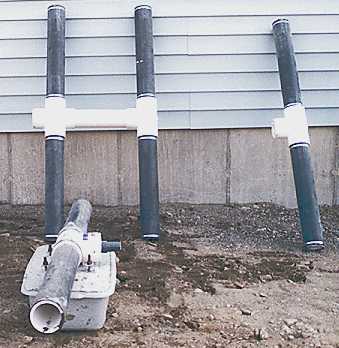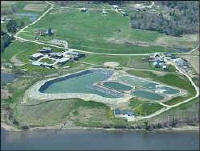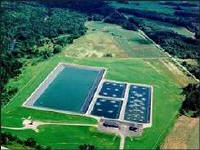|












2003
Maine Wastewater Salary Survey as conducted by the Maine Wastewater Control
Association

2003 Maine
Wastewater Rate Survey conducted by the Maine Rural
Water Association

Maine DEP Monthly
O & M Newsletter
Maine and WEF's
Operation Forum
Penobscot Watershed and Development of a TMDL
EPA Binational Toxics
Strategy
Maine Rural Water
Association
Maine Wastewater
Operator Certification
Guide
Maine Is Technology
Newsletter
Maine
Wastewater Control Association

Maine
Wastewater Engineering
Firms
| |
Choosing the Right Aeration
System
Will Fine Bubble
Aeration Systems
Work for You?
The following article presents an overview of a very complex subject: fine
bubble aeration systems. Appreciation is extended to the following
individuals who contributed to this article: Mary Michaud, Teresa Libby, Kevin
Flanders, Steve Cassidy, Kurt Marston, Anne Tischbein, Lisa Napolitano, Guy
Vaillancourt, Hugh Tozer, James Morris, Steve Woodard, Greg Cataldo, George BWm,
Charlene Powell, Wiff Peterson, Albert Presgraves, Doug McKeown, Tracy Planinsek,
Steve Fogg, Adam Yanutis, Henri Vincent, and Jim Fitch; and Chris Branch, City
of Lewiston, Maine; Russell Ferrelli, Bert LeBlanc, and Jim Lavacchia, Town of
Weston, Massachusetts

Activated
sludge aeration systems consume from 50 percent to 90 percent of the energy used
at most wastewater treatment plants, according to the U.S. EPA. A
significant component of operation and maintenance costs, aeration systems
have an equal effect on plant performance and capacity.
Many wastewater treatment facilities worldwide operate
inefficient and expensive aeration systems. As operators look to optimize their
plants and streamline costs, many turn to fine bubble technology. Compared to
many older systems, fine bubble aeration can reduce the power required to
transfer oxygen (and its associated costs) by up to 50 percent.
Would your wastewater treatment plant benefit by
replacing an older aeration system such as coarse bubble diffusion with
fine bubble technology? It's well worth investigating. It is important to
understand some critical terms, such as oxygen transfer efficiency and alpha,
before beginning your evaluation. The oxygen transfer efficiency of an aeration
system is the ratio of the amount of oxygen that actually dissolves into the
water to the total amount of oxygen pumped into the water. Only the dissolved
oxygen is available for treatment, and any portion of oxygen that does not
dissolve is a waste of energy and, therefore, money.
|
 |
|
EDI's Flex
Air fine bubble diffuser. Notice the
unit mounted on a dish pan full of cement. |
For clean water aeration, the oxygen transfer efficiency provided by fine bubble
diffusers usually exceeds that available from coarse bubble systems. In
wastewater, this may not always be the case. The design engineer and equipment
vendor use a factor called alpha to adjust the clean water transfer efficiency
to take into account the affects of wastewater characteristics on transfer
efficiency. Alpha is the ratio of oxygen transfer in a generic wastewater to
oxygen transfer in clean water. The clean water transfer efficiency multiplied
by alpha yields the wastewater transfer efficiency. When evaluating your system,
keep in mind that the use of generic or assumed values can pose problems. Your
wastewater may not behave like the assumed generic wastewater.
Many factors affect oxygen transfer efficiencies, alpha values, and ultimately
the performance of one aerator versus another. The following are some issues to
consider and understand when evaluating aeration systems.
 The
bubble size affects the oxygen transfer efficiency. Smaller bubbles have more
surface area per unit volume. This provides more area through which oxygen can
diffuse and thereby increase overall transfer efficiency. Visualize a basketball
filled with ping pong balls. Both take up the same volume, but the ping pong
balls have a much greater cumulative surface area. Also, since fine bubbles
provide larger total surface area, they create more friction and rise slower
than coarse bubbles. The combination of more transfer area and a greater contact
time enhances transfer efficiency. The
bubble size affects the oxygen transfer efficiency. Smaller bubbles have more
surface area per unit volume. This provides more area through which oxygen can
diffuse and thereby increase overall transfer efficiency. Visualize a basketball
filled with ping pong balls. Both take up the same volume, but the ping pong
balls have a much greater cumulative surface area. Also, since fine bubbles
provide larger total surface area, they create more friction and rise slower
than coarse bubbles. The combination of more transfer area and a greater contact
time enhances transfer efficiency.
 Surface
active agents (surfactants), such as detergents, lower alpha and the oxygen
transfer efficiency. By altering the surface tension, they often cause fine
bubbles to coalesce into fewer, larger bubbles. In addition, the thin film of
detergent molecules between the air bubble and the wastewater can act as a
barrier, increasing resistance to oxygen transfer. Surface
active agents (surfactants), such as detergents, lower alpha and the oxygen
transfer efficiency. By altering the surface tension, they often cause fine
bubbles to coalesce into fewer, larger bubbles. In addition, the thin film of
detergent molecules between the air bubble and the wastewater can act as a
barrier, increasing resistance to oxygen transfer.
 Fouling
decreases transfer efficiency. Most fine bubble systems being installed today
use a diffuser made of a flexible synthetic membrane with many small slits or a
ceramic disk with very fine holes. Both provide attractive sites for microbial
growth and precipitation of inorganic compounds. This type of fouling can cause
bubbles to coalesce, thereby decreasing the overall transfer efficiency. Fouling
decreases transfer efficiency. Most fine bubble systems being installed today
use a diffuser made of a flexible synthetic membrane with many small slits or a
ceramic disk with very fine holes. Both provide attractive sites for microbial
growth and precipitation of inorganic compounds. This type of fouling can cause
bubbles to coalesce, thereby decreasing the overall transfer efficiency.
 Finally,
aeration basin and aerator layout geometry can dramatically alter oxygen
transfer efficiency. Standard clean water transfer efficiency tests are usually
based on full floor aerator coverage. This creates a nearly ideal situation for
oxygen transfer. A turbulent counter-current flow regime is established with a
volume of water being dragged upward with the rising bubbles, being opposed by
an equal flow of water traveling downward. In large basins, such as lagoons,
full floor coverage is not normally needed to meet the biological aeration
demands. As a result of incomplete coverage, large scale currents can form a
spiral roll in the basins. The air bubbles flow with the water, which
significantly reduces the transfer efficiency. Compared with the full floor
configuration, many more air bubbles short-circuit their way to the top of the
aeration basin. Finally,
aeration basin and aerator layout geometry can dramatically alter oxygen
transfer efficiency. Standard clean water transfer efficiency tests are usually
based on full floor aerator coverage. This creates a nearly ideal situation for
oxygen transfer. A turbulent counter-current flow regime is established with a
volume of water being dragged upward with the rising bubbles, being opposed by
an equal flow of water traveling downward. In large basins, such as lagoons,
full floor coverage is not normally needed to meet the biological aeration
demands. As a result of incomplete coverage, large scale currents can form a
spiral roll in the basins. The air bubbles flow with the water, which
significantly reduces the transfer efficiency. Compared with the full floor
configuration, many more air bubbles short-circuit their way to the top of the
aeration basin.
Although it may be true that fine bubble systems can
provide an appreciable savings in many situations, those who purchase and
operate these systems without verification do so at the peril of their own
bottom line cost. How can you avoid this pitfall? First, test the system
proposed with your wastewater. Do not trust a vendor who does not recommend
oxygen transfer testing. Second, make sure that oxygen transfer testing mimics
the actual conditions, including the configuration of your basin. The cost of
aeration system testing can be high and may not be affordable for many plants.
Before testing, the potential cost savings of switching to fine bubble aeration
should be evaluated. Literature, vender, and EPA values for oxygen transfer
efficiently and alpha can be used. Find plants with similar wastewater to refine
from their experiences the values and contact plants to learn from their
experience. If the investment in fine bubble diffusion appears favorable,
consider testing before replacing the system.
Back To Aeration Fundamentals

|

